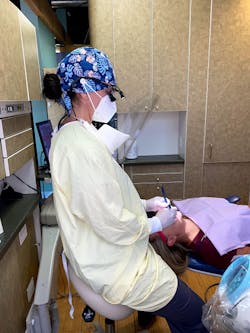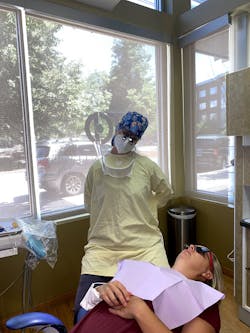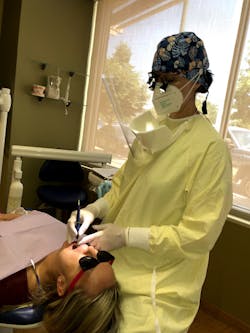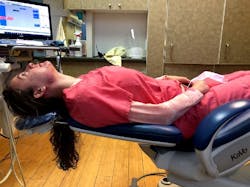Nearly 100% of hygienists have pain on the job. What can you do?
The dental hygiene profession is at high risk for musculoskeletal disorders (MSDs), with 96% of hygienists reporting pain due to their clinical work habits.1 High pain rates come from repetitive movements, bending, twisting, reaching, incorrect operator and patient positioning, and static posture. According to the Centers for Disease Control and Prevention (CDC), MSDs are the number one reason people are on disability.2 Since dental hygienists are at high risk for MSDs, it’s crucial to develop strong ergonomic habits. Focusing on ergonomics, including proper posture, positioning, and healthy habits, will help you practice pain-free for the duration of your career.
Ergonomics is the science of fitting the work environment (for dental professionals this is the operatory and patient) to the worker's needs. It’s about recognizing and respecting the human body's capabilities and limitations (no, it’s not designed to hunch over for hours), and designing the work environment to support those limitations. Practicing proper ergonomics can increase productivity, decrease pain, and lengthen one's career. Since it allows people to practice pain-free, ergonomics can increase the quality of life and work satisfaction.
Freshly minted dental hygienists need to develop good habits based on sound ergonomic principles to ensure a long and healthy career. Ergonomics not only help individuals in the workplace, but can improve the quality of their lives as well. When someone experiences pain due to poor clinical habits, it’s not easy to enjoy the activities they love outside of work. So, incorporating small and simple strategies in the operatory is the best bet for career longevity and satisfaction. Here I will cover neutral posture, microbreaks, and the importance of ergonomic operator and patient positioning.
Neutral posture (figure 1)
Neutral posture allows for the most support with the least amount of muscle strain. It is the position of the neck, shoulders, elbows, hips, and knees in which the flexor and extensor muscles of the body are balanced. This position is typically the mid-position of the joints—neck upright, shoulders relaxed, upper arms at sides, elbows flexed to 90 degrees, wrists straight, and fingers relaxed.3
For example, from the side, one could draw a straight line from the ear to the shoulder, then to the hip, then to the foot. Neutral posture for a dental hygienist means squared up to the surface or area being treated, the chin pulled back, and the arms at the sides with elbows bent at 90 degrees. It is not possible to maintain this posture 100% of the time, but it should be the goal to return to and maintain it as much as possible.
Microbreaks (figure 2)
When operators are not in neutral posture, they’re inherently in an awkward posture and often hold that for some time. This causes prolonged muscle contraction, which cuts off any blood supply that provides nutrients and oxygen to the tissue. When someone holds a static posture, they intrinsically cause damage to the tissue at a cellular level. The body needs to rest and regain blood flow in order to heal this damage.
Operators can promote recovery by taking microbreaks chairside and between patients. Studies show that taking microbreaks every 20 minutes reduces the pain and fatigue experienced by dental professionals.4 Microbreaks can easily be incorporated into a hygiene appointment. For example, a dental hygienist could stretch out his or her trapezius muscles chairside between scaling and polishing.
Operator positioning (figure 3)
It is essential to establish operator position before adjusting the patient. Establish a neutral posture, then adjust the patient chair and patient to support this posture. Operators should develop a routine where they adjust themselves, lean the patient chair back depending on which arch they will treat, adjust the headrest or use cushions as needed, and lower the patient chair to allow the forearms to be parallel to the floor. Then they need to pull the chin back to reduce forward head posture and keep the core engaged.
Patient positioning (figures 4a and 4b)
When positioning the patient, consider the orientation of the occlusal planes. The maxillary occlusal plane should be oriented at 10 to 20 degrees behind the vertical plane to ensure proper posture. The patient chair needs to be supine with the headrest angled down toward the floor, which encourages the patient’s chin to rise.
Conversely, the mandibular arch should be 30 degrees above the horizontal plane. For this, the patient needs to be semi-supine with the headrest angled forward to encourage the chin to tip downward.
There are many aspects to consider when practicing dentistry, from providing excellent care, to maintaining a busy schedule and managing equipment issues, the list can seem endless. However, practitioners cannot do these things while they’re injured or in pain. MSDs are shockingly common among dental providers.5 Incorporating proper ergonomics in the form of neutral posture, microbreaks, and correct positioning is crucial to job satisfaction and career longevity. Dental practitioners preach prevention to their patients. They must also practice what they preach and prevent imbalance and injury by incorporating proper ergonomics into their days.
References
- Yochim, AS. CE course: Musculoskeletal disorder prevention in dental hygiene. J Calif Dent Hygienists' Assoc. (2018);36(2):19-23. http://eds.a.ebscohost.com.proxy.wichita.edu/eds/pdfviewer/pdfviewer?vid=2&sid=0524c588-f63a-4ef4-a83b-faa38537e74d%40sdc-v-sessmgr03
- Disability and Health Related Conditions. cdc.gov. Updated September 16, 2020. Accessed June 11, 2021. https://www.cdc.gov/ncbddd/disabilityandhealth/relatedconditions.html
- Kroemer KHE, Grandjean E. Fitting the task to the human (5th ed.). 2001. Philadelphia: Taylor & Francis.
- Rajeswari SR, Gowda TM, Kumar TA, Arya K, Mehta DS. Assessment of interns and postgraduate dental student's knowledge regarding equipment ergonomics. Indian J Dent Res. 2016;27(3):256-261. doi:10.4103/0970-9290.186246
- Lietz J, Kozak A, Nienhaus A. Prevalence and occupational risk factors of musculoskeletal diseases and pain among dental professionals in western countries: a systematic literature review and meta-analysis. PLoS One. 2018;13:e0208628.
About the Author
Stephanie Botts, BSDH, RDH, CEAS
Stephanie Botts, BSDH, RDH, CEAS, has been a clinical dental hygienist for over 17 years. She is a certified ergonomics assessment specialist providing both in-office and virtual ergonomics consulting and coaching to dental professionals. She also provides CE to dental and dental hygiene associations on ergonomics. Stephanie believes that by learning effective strategies to optimize proper ergonomics, dental professionals can practice pain-free and ensure career longevity. She can be reached at [email protected] or on Instagram at @steph.polishedposture.





